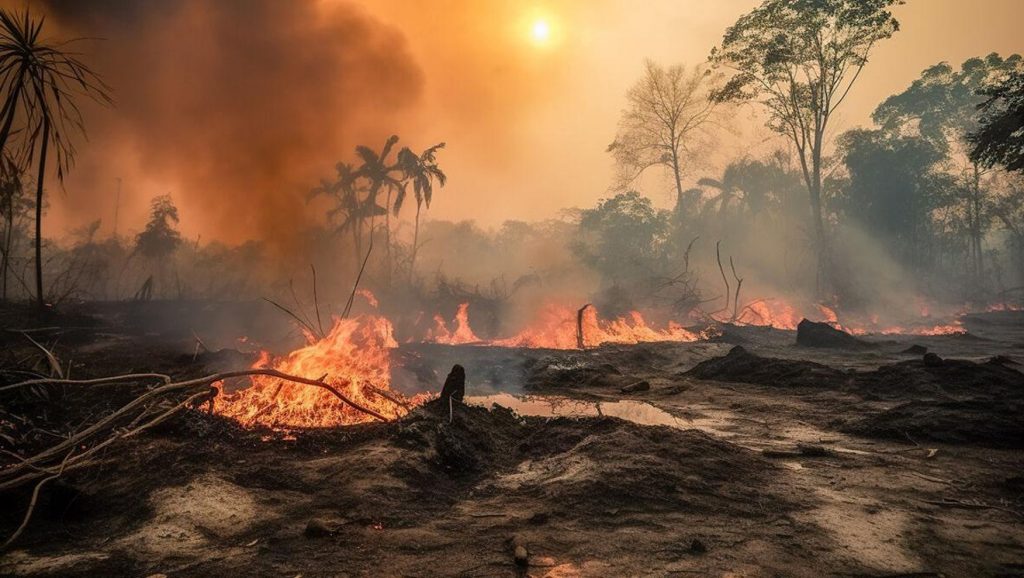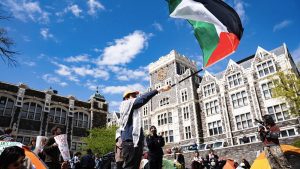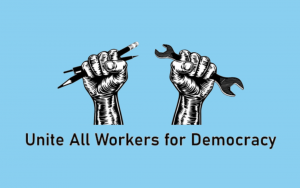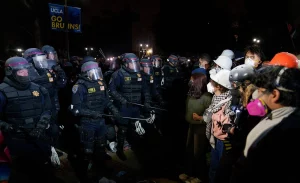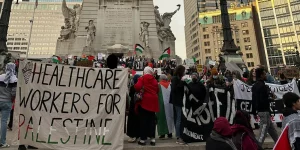On August 8, a wildfire began in Lahaina, Maui, that spread to affect over 3,200 acres of the island. As the former capital of the Hawaiian kingdom, Lahaina is a significant historical and cultural site for Native Hawaiians (Kanaka Maoli). So far, over 110 people have been killed by the wildfires, at least 20 people have been injured, and over a thousand people are still missing. At the center of this disaster is the long and ongoing struggle for water and land rights for Native Hawaiians.
These fires are the latest catastrophic event driven by climate change and made worse by generations of ecological mismanagement. In these conditions, wildfires like the one in Lahaina are becoming increasingly deadly and common, exacerbating the impacts on Indigenous communities who have deep ties to the affected land.
Climate change and other disasters are directly linked to capitalism in general, and the particularities of how colonization and imperialism played out in Hawaiʻi.
In the first hundred years of contact with the Western world, beginning with the British in the late 18th century, the population of Hawaiʻi was brutalized by disease, violence, and environmental degradation caused by the exploitation of the islands’ natural resources. Missionaries came from New England to attempt to convert the native population to Christianity, suppress traditional cultural practices, open religious schools, and assert political sway in the Western-influenced government. By 1840, Census records estimate that at least 84 percent of the native population was wiped out or left the islands.
Throughout the 19th century, the United States took considerable interest in Hawaiʻi for its raw natural resources and strategic geographic location for U.S. imperialist and military interests in the Pacific. Sugarcane became a primary resource, especially during the Civil War when the Northern states were cut off from the sugar grown in the South. Capitalists from the United States established sugar plantations and mills and shipped their products to sell in the United States. In the 1870s, the U.S. and the Hawaiian Kingdom signed a treaty that eliminated U.S. tariffs on sugar and rice, paving the way for plantation profits to nearly double.
As the native population declined, the sugarcane companies needed more and more laborers to tend to the sugar plantations, which led to Chinese, Japanese, and Portuguese workers arriving on the island looking for work. Meanwhile, the military brought more white Americans and their families.
In 1893, the “Hawaiian League,” a secret society of white businessmen assisted by the U.S. Navy, overthrew and jailed Queen Liliuokalani, the head of the sovereign Hawaiian government, and the U.S. officially annexed the islands as a colony in 1898.
As the military base and industries grew, so did settler-colonialism; eventually so many U.S. citizens were living on the islands (approximately 90 percent of their residents) that the territory was granted statehood in 1959. For Native Hawaiians, this statehood has never been welcome; it represented the corporate interests and settler-colonial stronghold in their rapidly changing home.
These corporate interests also produced Hawaiʻi’s water crisis, which set the stage for the tragedy in Lahaina. Before western intervention, Native Hawaiians sustained extensive regenerative agriculture and aquaculture systems that nourished its population and maintained the natural environment.
According to Uahikea Maile, who is Kanaka Maoli from Maunawili, Oʻahu, and an assistant professor of Indigenous politics in the department of political science at the University of Toronto, “pre-colonial Lahaina was a wetland ecosystem abundant with life … But … in the late 19th and early 20th centuries white-owned sugar plantations on Maui started to illegally divert water to their crops, drying up the wetlands. … These plantations also introduced non-native plant species for animal grazing that have helped fuel the Maui fires.”
Even long after the industry left the island, the dams were left behind, neglected by the capitalists who built them — and posing an ongoing hazard to the local communities.
The U.S. military has also been a major reason for the water crisis in Hawaiʻi, going back over a hundred years. The Pearl Harbor naval base was built on what had previously been a thriving sustainable fishpond, which, combined with the other nearly 360 fishponds around Hawaiʻi, fed around half a million people. By 1985, only seven of those fishponds remained. Today, the Pearl Harbor Naval Base is a designated superfund site on a federal list of polluted areas prioritized for cleanup.
In recent years, Hawaiʻi’s water crisis has worsened. Though the military has attempted to cover it up, Navy jet fuel contamination by the Red Hill Bulk Fuel Storage Facility built during World World II in Honolulu has threatened the water supply and posed health risks to the local population. These injustices have been met with the resistance of local water protectors, who demanded that the Navy shut down the fuel storage tanks — and won. However, less than a month later, the Navy reneged on its vow to shut down the fuel facility and the struggle has resumed. The deleterious social and environmental impact by the military is by no means felt on Hawai‘i alone — the U.S. military is driving environmental collapse around the planet.
On top of the military, the tourism industry guzzles water at an unsustainable rate while maintaining low wages for Hawaiian workers. And it is the Hawaiian people who pay most dearly for the water crisis. Last year, mandatory water restrictions were put in place in West Maui and Upcountry for locals with up to $500 fines, while no such restrictions were placed on the tourism industry, though it accounts for nearly half of the Big Island’s water consumption. The injustices are palpable, and many Native Hawaiians have been urging tourists to choose other locations as their vacation destinations as the crisis has worsened. Climate change is exacerbating the situation even further, and the dry conditions from years of capitalist water mismanagement and increasing temperatures laid the groundwork for the fires in Lahaina.
On top of the process of rebuilding, rescuing missing people, and healing, residents of Lahaina now have other dynamics to worry about — what people like Naomi Klein and Kapuaʻala Sproat are calling “plantation disaster capitalism.” Amid the ongoing search-and-rescue process, real estate developers and investors are already swooping in to try and profit off of the devastation.
Many fear that the fires will result in an exodus of the Native population from Lahaina, many of whom are already being contacted by real estate developers to buy their homes for tourism. From post-World War II Europe to Hurricane Katrina, the bourgeoisie uses catastrophe for the working class as a fertile source of “regeneration” for their own profits.
President Biden, who wants to position himself favorably on issues of climate change and Indigenous rights with the upcoming elections, traveled to Maui on Monday to meet with communities affected by the wildfires. But for most Native Hawaiians who do not consider themselves to be American and have no identification with the imperialist empire that has ravaged its population and natural resources and violated its nation’s sovereignty, this visit is unwelcome.
As part of its response to the Maui wildfires, Biden promised a one-time payment of $700 per household to applicants who were displaced from their homes, an amount far from adequate to meet the needs of residents in the wake of the disaster. Meanwhile, the U.S. government has sent nearly a hundred billion dollars to engage in a proxy war in Ukraine.
While Biden promised to be a “climate president,” he has been far from it, approving oil drilling projects, like the Willow project in Alaska, and auctioning off drilling projects in the Gulf of Mexico. These projects continue the burning of fossil fuels, directly contribute to climate change, threaten water and land, and undermine Indigenous sovereignty and self-determination. But this is not an aberration — Biden ultimately answers to capitalists and the market, which demand the continued burning of fossil fuels to secure profits.
In the wake of this disaster, it’s essential to put forward a perspective of self-determination for the Native Hawaiian people, whose labor, cultural, land, and water rights have long been degraded for the sake of capitalist profits. Lahaina must be rebuilt under the leadership of Native Hawaiians and the working class — not the disaster capitalists who hope to continue the cycle of exploitation of the islands’ rich natural resources and human labor. A clear first demand must be to end the militarization of Hawaii by demanding U.S. troops and bases out of Hawaiʻi and to restore the natural environment under the leadership of Hawaiians themselves.


